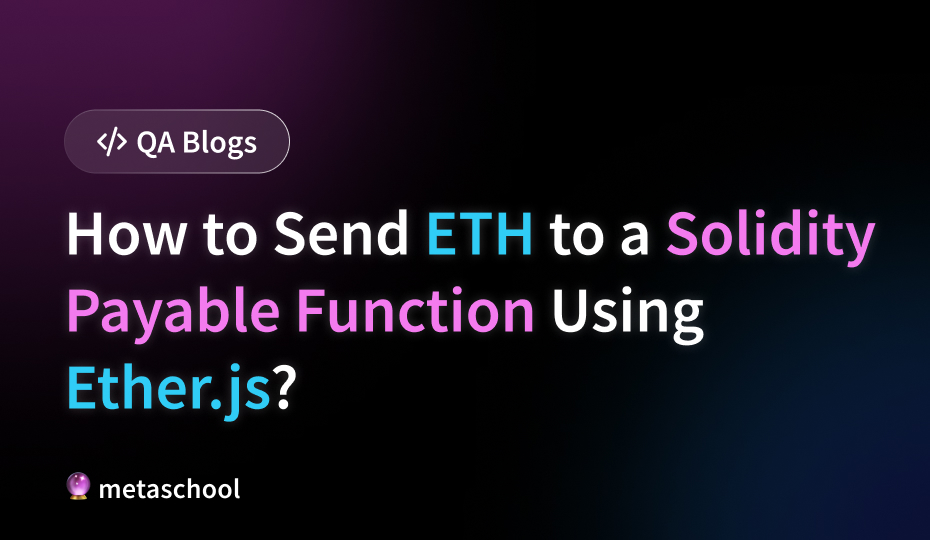ethers.js: Send ETH to Payable Smart Contract Function
Learn how to seamlessly send Ether to payable smart contract functions using the power and simplicity of ethers.js.
Learn how to seamlessly send Ether to payable smart contract functions using the power and simplicity of ethers.js.
This guide provides a step-by-step breakdown of how to send Ether (ETH) to a payable function in a smart contract using ethers.js, a popular JavaScript library for interacting with the Ethereum blockchain.
Import ethers.js:
import { ethers } from 'ethers';Connect to your Ethereum provider:
const provider = new ethers.providers.Web3Provider(window.ethereum);Get the signer (your connected wallet):
const signer = provider.getSigner();Create a contract instance:
const contract = new ethers.Contract(contractAddress, contractABI, signer);Define the ETH value to send:
const valueToSend = ethers.utils.parseEther("1.0"); // 1 ETHCall the payable function with the value:
const tx = await contract.myPayableFunction({ value: valueToSend });Explanation:
ethers.utils.parseEther("1.0") converts 1 ETH to its wei equivalent.value property in the options object specifies the amount of ETH to send.await keyword waits for the transaction to be mined.Note:
contractAddress and contractABI with the actual values.payable in the Solidity contract.value option.This JavaScript code demonstrates how to send 1 ETH to a smart contract using ethers.js. It connects to the user's Ethereum wallet, retrieves the contract instance, and calls a payable function on the contract with the specified ETH value. The code includes error handling and waits for the transaction to be confirmed on the blockchain.
import { ethers } from 'ethers';
// Replace with your contract address and ABI
const contractAddress = '0x...';
const contractABI = [
// ... your contract ABI ...
];
async function sendEthToContract() {
try {
// Connect to the Ethereum provider
const provider = new ethers.providers.Web3Provider(window.ethereum);
// Request account access if needed
await provider.send("eth_requestAccounts", []);
// Get the signer
const signer = provider.getSigner();
// Create a contract instance
const contract = new ethers.Contract(contractAddress, contractABI, signer);
// Define the ETH value to send (1 ETH in this example)
const valueToSend = ethers.utils.parseEther("1.0");
// Call the payable function with the value
const tx = await contract.myPayableFunction({ value: valueToSend });
// Wait for the transaction to be mined
await tx.wait();
console.log('Transaction successful:', tx.hash);
} catch (error) {
console.error('Error sending ETH:', error);
}
}
// Call the function to send ETH
sendEthToContract();Explanation:
window.ethereum and gets the signer to interact with the blockchain.ethers.utils.parseEther to convert ETH to wei.myPayableFunction on your contract, passing the ETH value in the value field of the options object.try...catch block to handle potential errors during the process.Remember to:
contractAddress and contractABI with your actual contract details.myPayableFunction in this example) is indeed marked as payable in your Solidity contract.contract.estimateGas.myPayableFunction(...) before sending the transaction to avoid potential failures due to insufficient gas.contract.estimateGas.myPayableFunction({ value: valueToSend }) before sending the transaction. This helps prevent failures due to insufficient gas and protects you from unexpected gas costs.payable functions, gas, and security best practices: https://docs.soliditylang.org/
This code snippet demonstrates how to send Ether (ETH) to a payable function in a smart contract using the ethers.js library.
Here's a breakdown:
ethers.utils.parseEther(), which converts from human-readable ETH to its equivalent in wei.value property within the options object passed to the function call.await to wait for the transaction to be mined and confirmed by the network.Key Points:
payable.This comprehensive guide explained how to send ETH to a payable function in a smart contract using ethers.js. By following these steps, developers can enable secure and efficient ETH transfers within their decentralized applications. Remember to prioritize security best practices, such as gas estimation and re-entrancy attack prevention, to ensure the robustness and reliability of your smart contracts. As you delve deeper into blockchain development, continue exploring the rich features of ethers.js and Solidity to unlock the full potential of decentralized applications.
 How to Send ETH to a Solidity Payable Function Using Ether.js? - | A Solidity payable function allows you to receive ether as an input parameter. Payable function allows the caller to input ether.
How to Send ETH to a Solidity Payable Function Using Ether.js? - | A Solidity payable function allows you to receive ether as an input parameter. Payable function allows the caller to input ether. Documentation | Documentation for ethers, a complete, tiny and simple Ethereum library.
Documentation | Documentation for ethers, a complete, tiny and simple Ethereum library. My first taste of building a Web3 app with Solidity, React and ... | Lately I have a lot of time on my hands. Centralized exchanges are blowing up everywhere, not doing so great during these difficult times…
My first taste of building a Web3 app with Solidity, React and ... | Lately I have a lot of time on my hands. Centralized exchanges are blowing up everywhere, not doing so great during these difficult times… Contracts — Solidity 0.8.29 documentation | One way to create contracts programmatically on Ethereum is via the JavaScript API web3.js. It has a function called web3.eth.Contract to facilitate contract ...
Contracts — Solidity 0.8.29 documentation | One way to create contracts programmatically on Ethereum is via the JavaScript API web3.js. It has a function called web3.eth.Contract to facilitate contract ...